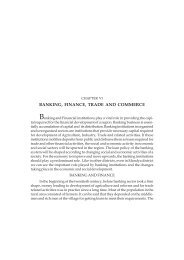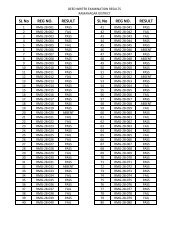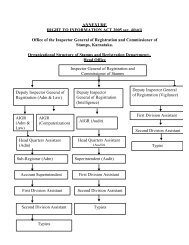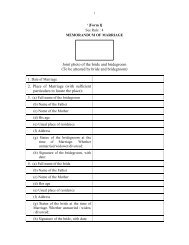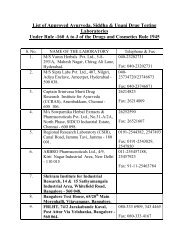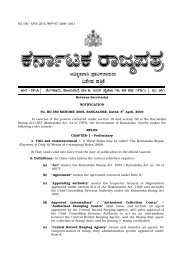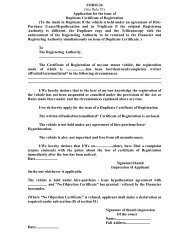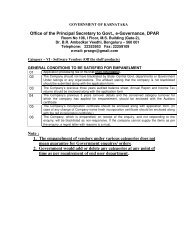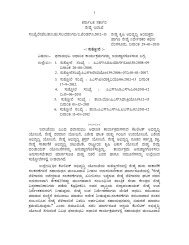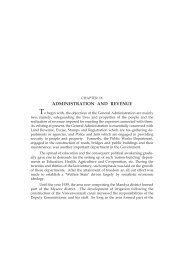KEA Guidelines on Writing Concept Note for Evaluations.pdf
KEA Guidelines on Writing Concept Note for Evaluations.pdf
KEA Guidelines on Writing Concept Note for Evaluations.pdf
You also want an ePaper? Increase the reach of your titles
YUMPU automatically turns print PDFs into web optimized ePapers that Google loves.
<str<strong>on</strong>g>KEA</str<strong>on</strong>g> <str<strong>on</strong>g>Guidelines</str<strong>on</strong>g> <strong>on</strong> <strong>Writing</strong> C<strong>on</strong>cept <strong>Note</strong> <strong>for</strong> Evaluati<strong>on</strong>sA ‘c<strong>on</strong>cept note’ or an ‘an evaluati<strong>on</strong> proposal’ is a good first step <strong>for</strong>launching an evaluati<strong>on</strong> study. It is necessary if the evaluati<strong>on</strong> study is beingentrusted to Karnataka Evaluati<strong>on</strong> Authority (<str<strong>on</strong>g>KEA</str<strong>on</strong>g>) by a line department oragency. <str<strong>on</strong>g>KEA</str<strong>on</strong>g> and the independent external evaluator may not understand andappreciate the need <strong>for</strong> the study like the implementing agency or department does.Each <strong>on</strong>e of these troika can have widely varying expectati<strong>on</strong>s about the proposedevaluati<strong>on</strong> and what it is expected to produce. C<strong>on</strong>cept note is a brief proposalc<strong>on</strong>taining the rati<strong>on</strong>ale <strong>for</strong> taking up the evaluati<strong>on</strong> study at this point of time; listskey issues to be investigated, indicates what the department is looking <strong>for</strong> in thestudy report and how the findings and recommendati<strong>on</strong>s will be utilized. It shouldhelp in locating the bottom line <strong>for</strong> the study, given the real world c<strong>on</strong>straints ofdata, time, m<strong>on</strong>ey and political import. It is a short scoping note of 2-3 pages <strong>on</strong>ly.There is no need <strong>for</strong> literature review, citati<strong>on</strong>s, data etc. It needs to c<strong>on</strong>tain <strong>on</strong>ly 3-4 paragraphs <strong>on</strong> the following items:1. Background: This secti<strong>on</strong> includes a brief background of the implementingdepartment/agency, outline of the program/scheme, its role and importance, howl<strong>on</strong>g it is under implementati<strong>on</strong>, expenditure incurred in the last 3-5 years,human resourced deployed by the department/agency, program/schemeachievements, number of citizens benefitted, intended future coverage, etc.2. Scope of the study: This secti<strong>on</strong> states the major challenges in implementing theprogram/scheme, ef<strong>for</strong>ts made by the department/agency to overcome theminternally and the progress made so far, unresolved core/real life issues (a <strong>on</strong>esentence statement of the research/evaluati<strong>on</strong> questi<strong>on</strong>s that the study shouldaddress), the need and urgency <strong>for</strong> taking up an evaluati<strong>on</strong> study now, data/in<strong>for</strong>mati<strong>on</strong> and budget available <strong>for</strong> the study, time line within which the studyshould be completed, how the findings will be utilized etc.3. Title: Title of the study needs to be catchy, in<strong>for</strong>mative and distinctive. Two-parttitle is ideal. The first part should be short and catchy. The sec<strong>on</strong>d part can be
more descriptive / in<strong>for</strong>mative. Length of the title should not ordinarily exceedabout 20 words. It should reflect the essence of proposed study.4. Supplementary in<strong>for</strong>mati<strong>on</strong>: Here the department/agency my list the potentialevaluators if they have a ready list. Else they may suggest as to what kind ofevaluati<strong>on</strong> agency they are looking <strong>for</strong> (they can name some agencies also).They may also suggest what methodologies they have in mind, what additi<strong>on</strong>alevidence is to be gathered, c<strong>on</strong>tact in<strong>for</strong>mati<strong>on</strong> <strong>for</strong> getting additi<strong>on</strong>al details etc.The aim of a c<strong>on</strong>cept paper is to provide a clear summary of the evaluati<strong>on</strong>study. It should enable a casual reader to understand what the client wants toinvestigate <strong>for</strong> meeting the development objectives of his/her organizati<strong>on</strong>.Following the receipt of the c<strong>on</strong>cept note, <str<strong>on</strong>g>KEA</str<strong>on</strong>g> will hold discussi<strong>on</strong>s with thekey officers of the department/agency to understand their needs better. It willlead to a better understanding between the department/agency and the <str<strong>on</strong>g>KEA</str<strong>on</strong>g> <strong>on</strong>the evaluati<strong>on</strong> design that best resp<strong>on</strong>ds to the purpose, tentative costs, potentialagencies, method of choosing the evaluator, m<strong>on</strong>itoring arrangements, utilizati<strong>on</strong>of the findings, political and organizati<strong>on</strong>al implicati<strong>on</strong>s etc. Incepti<strong>on</strong> report isnot necessary <strong>for</strong> internal evaluati<strong>on</strong>s. Instead, departments/agencies shouldc<strong>on</strong>sult the <str<strong>on</strong>g>KEA</str<strong>on</strong>g> and straight away submit a ToR and seek its approval.*******



